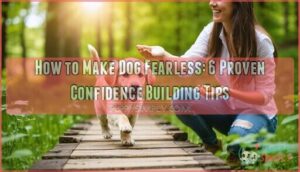This site is supported by our readers. We may earn a commission, at no cost to you, if you purchase through links.
 You can’t truly make your dog fearless, but you can build their confidence through gradual exposure and positive reinforcement.
You can’t truly make your dog fearless, but you can build their confidence through gradual exposure and positive reinforcement.
Start by staying calm yourself—dogs pick up on your energy like emotional sponges. Use treats and praise when they face scary situations, even baby steps count.
Practice desensitization by slowly introducing them to triggers at a distance they can handle. Think of it like teaching a kid to swim—you wouldn’t throw them in the deep end first.
Regular exercise also helps burn off nervous energy that fuels anxiety. Remember, building confidence takes time, but the transformation from scaredy-cat to brave buddy is worth every patient moment.
Table Of Contents
- Key Takeaways
- What is Fear in Dogs?
- Signs of Fearful Dogs
- How to Build Confidence in an Insecure Dog
- How Often Should I Exercise My Dog?
- What Are The Signs of a Confident Dog?
- How Do I Make My Dog Braver?
- Frequently Asked Questions (FAQs)
- How to train a fearful dog?
- How do I help a fearful dog gain confidence?
- How can a Shy Dog gain confidence?
- How can I Help my Dog avoid fear?
- How do you train a frightened dog?
- What if my dog is fearful?
- How to teach your dog to be fearless?
- How do I make my dog braver?
- How do I get my dog to stop being so scared?
- Why is my dog so coward?
- Conclusion
Key Takeaways
- Stay calm and confident yourself – Your dog mirrors your energy, so maintaining steady, positive leadership during scary situations helps them feel secure and builds their trust in you.
- Use positive reinforcement consistently – Reward every small brave moment with treats and enthusiastic praise to create positive associations with previously frightening experiences.
- Practice gradual desensitization – Start by exposing your dog to triggers at a comfortable distance, slowly decreasing the distance over time while pairing the experience with rewards.
- Provide regular exercise and mental stimulation – A tired dog is often a calmer, more confident dog, and physical activity combined with puzzle toys helps reduce anxiety-driven behaviors.
What is Fear in Dogs?
When your dog tucks their tail between their legs or hides behind your couch, they’re experiencing genuine fear.
Your pup’s trembling isn’t just nervousness—it’s their heart crying out for safety and reassurance.
Dog fear stems from genetic predisposition, early traumas impact, or medical causes creating anxiety manifestations.
Fear triggers range from thunderstorms to strangers approaching too quickly.
Your fearful dog behavior might include trembling, excessive panting, or even aggression when cornered.
Reading dog body language helps you recognize these signals early.
Dog anxiety isn’t just "bad behavior"—it’s your pup’s way of saying they need your help feeling safe again.
To address this, consider implementing desensitization and counterconditioning techniques.
This approach can help your dog overcome their anxiety and feel more secure.
Signs of Fearful Dogs
Recognizing the signs of a fearful dog can feel like reading a foreign language, but your pup’s body speaks volumes.
Watch for these telltale behaviors that scream "I’m scared":
- Hiding behind furniture or retreating to corners when visitors arrive
- Tucked tail pressed tightly against their belly like they’re trying to disappear
- Avoidance of eye contact, turning their head away from perceived threats
- Excessive panting even when it’s not hot or after exercise
- Submissive peeing during greetings or stressful encounters
Understanding dog body language helps you identify fear before it escalates.
How to Build Confidence in an Insecure Dog
Building confidence in a fearful dog isn’t about overnight magic tricks, but rather consistent, patient work that shows your pup the world isn’t as scary as they think.
Building your dog’s courage takes time, but every small brave moment becomes a building block for their confidence.
You’ll need to become your dog’s cheerleader, using positive experiences and gradual exposure to help them discover their inner brave heart, one small victory at a time.
Every small step forward is a giant leap toward your dog’s fearless future.
Be a Confident Dog Owner
Your energy sets the tone for everything. Dogs mirror their owner’s emotions, so calm assertiveness becomes your secret weapon for dog confidence training.
When you’re nervous during walks, they’ll feel it too.
| Your Energy | Your Dog’s Response |
|---|---|
| Confident & calm | Relaxed and trusting |
| Anxious & tense | Fearful and reactive |
| Inconsistent signals | Confused behavior |
Leadership skills mean staying steady when they’re scared. Consistent training with positive reinforcement works best when you’re genuinely confident.
Reading signals helps you respond appropriately. Remember, seeking guidance from professionals isn’t giving up—it’s smart dog socialization strategy that builds both your skills.
Positive Reinforcement
Your confident energy sets the foundation, but positive reinforcement truly transforms fearful pups.
Treat rewards work like magic when paired with enthusiastic praise—your cheerful "Good dog!" means everything to them. Keep training sessions short and consistent, using simple commands like "Yes!" to mark brave moments.
Even tiny victories deserve celebration, whether it’s lifting their head or taking one step forward. This confidence building approach creates positive associations that stick.
To enhance the reward system, consider using high value dog treats. Remember, your enthusiastic tone and timing make all the difference in helping your dog discover their inner courage through patient, reward-based training.
Desensitization and Counter-Conditioning
Why does your dog shake at thunderstorms but sleep through sirens? Desensitization and counter-conditioning tackle dog fear by changing how your pup responds to triggers.
This fearful dog training method builds dog confidence through careful trigger identification and gradual exposure.
Here’s your game plan:
- Start with distance management – keep scary stimuli far enough away that your dog notices but doesn’t panic
- Create positive associations by pairing treats with the trigger at low intensity
- Watch your dog’s body language closely to avoid pushing too hard too fast.
Many owners also find that occasional calming support can be beneficial during this process.
How Often Should I Exercise My Dog?
You’ve probably noticed that a tired dog is often a calmer, more confident dog, and there’s real science behind this connection.
Regular exercise doesn’t just burn off your pup’s excess energy—it actually helps build their self-assurance by releasing feel-good hormones and giving them positive experiences to conquer their world, one walk at a time, which leads to a more confident dog.
Bolting No More: How to Keep Your Dog From Jumping Fence
Building your fearful pup’s confidence means keeping them safely contained while they learn to trust.
A fence-jumping dog isn’t just seeking adventure—they’re often running from fear or anxiety.
Start with fence height modifications and digging prevention measures like buried chicken wire to create secure boundaries.
Boundary training works wonders when combined with positive reinforcement.
Teach "stay" commands near the fence, rewarding calm behavior with treats and praise.
Leash alternatives like long training leads give nervous dogs freedom while maintaining control during yard enrichment activities.
Mental stimulation through puzzle toys reduces escape urges born from boredom or dog fear.
Regular exercise paired with dog training sessions helps build dog confidence naturally.
Remember, dog socialization tips include creating positive fence-line experiences—let your dog observe the world safely from their secure space.
Consistency beats force every time when building a fearless companion.
How Often Should You Walk Your Dog? Here’s What to Consider
While keeping your dog safely contained prevents escapes, the real confidence-building magic happens during regular walks.
Walk frequency plays a vital role in developing your dog’s fearlessness and social skills.
Most dogs thrive with 20-30 minute daily walks, but breed specifics matter tremendously.
High-energy breeds need more exercise, while smaller dogs might need shorter, more frequent outings.
Age considerations are equally important – puppies require brief, frequent walks, while senior dogs benefit from gentler, consistent routines.
Health conditions and weather impact should guide your decisions.
Never push a dog with joint issues, and extreme temperatures can harm rather than help confidence building.
Sniffing enriches walks, providing mental stimulation.
Here’s what regular walks provide for fearful dogs:
- Controlled exposure to new sights, sounds, and smells
- Positive reinforcement opportunities when they handle challenges well
- Dog socialization tips through meeting other dogs and people
- Consistent dog training moments that build trust
Remember, consistent walking schedules create predictable routines that anxious dogs crave for security.
Regular walks are essential for developing your dog’s social skills and fearlessness, making them a crucial part of any dog’s life.
The Complete Guide to Off Leash Dog Training
While mastering basic commands indoors is great, off-leash training transforms your anxious pup into a confident companion who trusts you completely.
This advanced dog behavior modification technique requires solid recall training as your foundation—your dog must come every single time you call, no exceptions. Start with boundary training in your fenced backyard, practicing positive reinforcement techniques when your dog stays close.
Gradually introduce distraction management by having friends create controlled chaos while you work on commands. Some trainers recommend e-collar use for stubborn cases, but patience usually wins. Many owners find a training collar useful for reinforcing commands.
Dog exposure therapy works wonders here—begin in quiet areas before progressing to busier environments. Your dog’s anxiety treatment includes building confidence through successful off-leash experiences that prove they can handle freedom responsibly.
Remember, public safety depends on your dog’s reliability. Never rush this process. When your pup confidently explores while checking in with you naturally, you’ll both enjoy incredible adventures together. These dog training techniques create unbreakable bonds built on mutual trust and respect.
Dog in Heat? Learn How to Handle The Dog Heat Cycle & Keep Your Dog Safe
When your female dog enters her heat cycle, she might show signs of dog anxiety treatment needs.
Heat Cycle Stages bring Behavioral Changes that can worsen separation anxiety dog issues.
Managing Symptoms includes keeping her indoors to focus on Preventing Pregnancy while addressing Hygiene Concerns.
Maintaining routines helps with calming fearful dog behaviors during this stressful time.
What Are The Signs of a Confident Dog?
You’ve worked hard on exercise routines, but now you’re wondering if your efforts are paying off. Spotting the signs of a confident dog helps you track your progress and celebrate those wins.
A confident dog displays unmistakable positive body language that’s hard to miss. Their confident posture speaks volumes – shoulders back, head held high, and tail in a neutral or slightly raised position. You’ll notice their relaxed body language during social interactions, showing they’re comfortable in their own skin.
Here are three key signs your dog’s confidence is blooming:
- Playful engagement – They initiate games and approach new experiences with curiosity rather than fear
- Calm demeanor – They handle unexpected sounds or situations without excessive stress responses
- Social interactions – They greet people and other dogs with interest instead of cowering or hiding
When you see these confidence-building behaviors emerging, you’ll know your dog behavior training is working beautifully. However, if your dog exhibits opposite behaviors, it may be a sign they’re dog acting paranoid.
How Do I Make My Dog Braver?
Building your dog’s bravery doesn’t happen overnight, but these dog fear solutions can help boost dog confidence effectively.
Through consistent counterconditioning and creating safe spaces, you’ll notice gradual improvements in your pup’s courage.
Here are proven methods for dog fear reduction:
- Trick Training – Teaching new commands builds self-esteem and strengthens your bond
- Puzzle Toys – Mental stimulation encourages problem-solving and reduces anxiety
- Socialization Tips – Gradual exposure to new experiences creates positive associations
- Safe Interaction – Let your dog approach people naturally while you toss treats nearby
These confidencebuilding techniques help scared dogs develop lasting courage through patience and consistency.
Frequently Asked Questions (FAQs)
How to train a fearful dog?
Like planting seeds in rocky soil, you’ll need patience.
Start with positive reinforcement and treats.
Create safe spaces, avoid punishment, and gradually expose them to fears.
Short training sessions work best—Rome wasn’t built overnight, which requires gradually exposing them to their fears over time.
How do I help a fearful dog gain confidence?
Start with baby steps—reward every small brave moment with treats and praise.
Create positive associations by pairing scary things with good experiences.
Let your pup set the pace while you cheer them on.
How can a Shy Dog gain confidence?
Patience and positive reinforcement pave the path forward.
You’ll build your shy pup’s confidence through gentle exposure, tasty treats, and consistent praise.
Don’t rush—let them set the pace while celebrating small victories together.
How can I Help my Dog avoid fear?
You can prevent fear by socializing your puppy early, using positive reinforcement consistently, and creating safe spaces at home.
Avoid forcing interactions, watch for stress signals, and pair new experiences with treats to build positive associations.
How do you train a frightened dog?
You’ll need patience and positive reinforcement to help your frightened pup.
Start with short, gentle training sessions using treats and praise.
Create safe spaces, avoid punishment, and let them progress at their own comfortable pace.
What if my dog is fearful?
Your heart breaks seeing them cower, but there’s hope.
Start with gentle counterconditioning—pair scary things with treats.
Create safe spaces, use positive reinforcement, and never force interactions.
Progress takes time, patience wins.
How to teach your dog to be fearless?
Start with small victories—teach simple tricks like "sit" or "touch."
Use treats and praise generously when your dog shows brave behavior.
Gradually expose them to new experiences at their comfort level, building confidence step by step.
How do I make my dog braver?
Build your dog’s courage through positive experiences and gradual exposure.
Reward brave behaviors with treats and praise.
Practice basic commands to boost confidence.
Create safe spaces and avoid forcing scary situations.
Patience and consistency work wonders.
How do I get my dog to stop being so scared?
Scared scenarios substantially stress sensitive dogs.
Start small with gradual exposure to triggers while offering high-value treats.
Create positive associations through patience and consistency.
Don’t rush—let your pup progress at their own comfortable pace.
Why is my dog so coward?
Your dog’s fearful behavior likely stems from lack of early socialization, genetics, past trauma, or medical issues causing pain.
Dogs naturally avoid unfamiliar situations to stay safe, but you can help build their confidence gradually.
Conclusion
Remember, transforming your nervous pup into a confident companion is like watching a flower bloom—it takes patience, but the results are beautiful.
Learning how to make dog fearless isn’t about eliminating all fears overnight; it’s about building unshakeable trust between you two.
Stay consistent with positive reinforcement, practice desensitization regularly, and celebrate small victories along the way.
Your dog’s newfound courage will shine through as they face the world with their tail wagging high.









